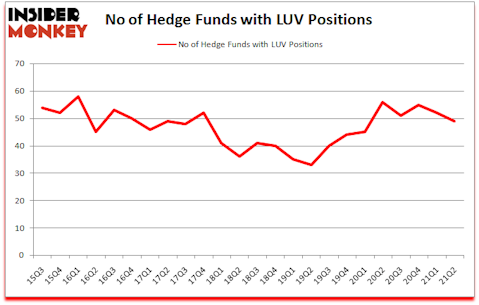Our extensive research has shown that imitating the smart money can generate significant returns for retail investors, which is why we track nearly 900 active prominent money managers and analyze their quarterly 13F filings. The stocks that are heavily bought by hedge funds historically outperformed the market, though there is no shortage of high profile failures like hedge funds’ 2018 losses in Facebook and Apple. Let’s take a closer look at what the funds we track think about Southwest Airlines Co. (NYSE:LUV) in this article.
Is Southwest Airlines Co. (NYSE:LUV) a good investment now? The smart money was taking a bearish view. The number of long hedge fund bets were trimmed by 3 lately. Southwest Airlines Co. (NYSE:LUV) was in 49 hedge funds’ portfolios at the end of the second quarter of 2021. The all time high for this statistic is 58. Our calculations also showed that LUV isn’t among the 30 most popular stocks among hedge funds (click for Q2 rankings).
Why do we pay any attention at all to hedge fund sentiment? Our research has shown that a select group of hedge fund holdings outperformed the S&P 500 ETFs by 79 percentage points since March 2017 (see the details here). That’s why we believe hedge fund sentiment is an extremely useful indicator that investors should pay attention to.

Richard Gerson of Falcon Edge Capital
At Insider Monkey, we scour multiple sources to uncover the next great investment idea. For example, lithium mining is one of the fastest growing industries right now, so we are checking out stock pitches like this emerging lithium stock. We go through lists like the 10 best EV stocks to pick the next Tesla that will deliver a 10x return. Even though we recommend positions in only a tiny fraction of the companies we analyze, we check out as many stocks as we can. We read hedge fund investor letters and listen to stock pitches at hedge fund conferences. You can subscribe to our free daily newsletter on our homepage. Keeping this in mind let’s take a look at the new hedge fund action regarding Southwest Airlines Co. (NYSE:LUV).
Do Hedge Funds Think LUV Is A Good Stock To Buy Now?
At second quarter’s end, a total of 49 of the hedge funds tracked by Insider Monkey were long this stock, a change of -6% from the first quarter of 2020. By comparison, 56 hedge funds held shares or bullish call options in LUV a year ago. So, let’s see which hedge funds were among the top holders of the stock and which hedge funds were making big moves.

Of the funds tracked by Insider Monkey, Renaissance Technologies, holds the most valuable position in Southwest Airlines Co. (NYSE:LUV). Renaissance Technologies has a $118.9 million position in the stock, comprising 0.1% of its 13F portfolio. The second most bullish fund manager is PAR Capital Management, managed by Paul Reeder and Edward Shapiro, which holds a $112.4 million position; 2.8% of its 13F portfolio is allocated to the company. Some other professional money managers with similar optimism consist of Ken Griffin’s Citadel Investment Group, Israel Englander’s Millennium Management and Ben Levine, Andrew Manuel and Stefan Renold’s LMR Partners. In terms of the portfolio weights assigned to each position Lodge Hill Capital allocated the biggest weight to Southwest Airlines Co. (NYSE:LUV), around 7.16% of its 13F portfolio. PAR Capital Management is also relatively very bullish on the stock, designating 2.75 percent of its 13F equity portfolio to LUV.
Due to the fact that Southwest Airlines Co. (NYSE:LUV) has witnessed a decline in interest from the aggregate hedge fund industry, logic holds that there lies a certain “tier” of hedgies that decided to sell off their full holdings heading into Q3. Intriguingly, D. E. Shaw’s D E Shaw said goodbye to the biggest investment of all the hedgies monitored by Insider Monkey, totaling about $45.6 million in stock, and Bart Baum’s Ionic Capital Management was right behind this move, as the fund dumped about $30.7 million worth. These moves are important to note, as total hedge fund interest fell by 3 funds heading into Q3.
Let’s go over hedge fund activity in other stocks similar to Southwest Airlines Co. (NYSE:LUV). We will take a look at Carnival Corporation & plc (NYSE:CCL), Waste Connections, Inc. (NYSE:WCN), Copart, Inc. (NASDAQ:CPRT), Lennar Corporation (NYSE:LEN), Ferguson plc (NYSE:FERG), PACCAR Inc (NASDAQ:PCAR), and AMETEK, Inc. (NYSE:AME). This group of stocks’ market values match LUV’s market value.
| Ticker | No of HFs with positions | Total Value of HF Positions (x1000) | Change in HF Position |
|---|---|---|---|
| CCL | 31 | 456173 | -13 |
| WCN | 32 | 763813 | 1 |
| CPRT | 44 | 992348 | -5 |
| LEN | 50 | 1974872 | 1 |
| FERG | 11 | 6877154 | 6 |
| PCAR | 28 | 623669 | 0 |
| AME | 38 | 912985 | 6 |
| Average | 33.4 | 1800145 | -0.6 |
View table here if you experience formatting issues.
As you can see these stocks had an average of 33.4 hedge funds with bullish positions and the average amount invested in these stocks was $1800 million. That figure was $926 million in LUV’s case. Lennar Corporation (NYSE:LEN) is the most popular stock in this table. On the other hand Ferguson plc (NYSE:FERG) is the least popular one with only 11 bullish hedge fund positions. Southwest Airlines Co. (NYSE:LUV) is not the most popular stock in this group but hedge fund interest is still above average. Our overall hedge fund sentiment score for LUV is 76.1. Stocks with higher number of hedge fund positions relative to other stocks as well as relative to their historical range receive a higher sentiment score. Our calculations showed that top 5 most popular stocks among hedge funds returned 95.8% in 2019 and 2020, and outperformed the S&P 500 ETF (SPY) by 40 percentage points. These stocks gained 22.9% in 2021 through October 1st and still beat the market by 5.6 percentage points. Hedge funds were also right about betting on LUV as the stock returned 2.4% since the end of Q2 (through 10/1) and outperformed the market. Hedge funds were rewarded for their relative bullishness.
Follow Southwest Airlines Co (NYSE:LUV)
Follow Southwest Airlines Co (NYSE:LUV)
Suggested Articles:
- 15 Best Gold Mining Stocks to Invest In
- 16 Largest Financial Services Companies
- 15 Biggest Water Treatment Companies In The World
Disclosure: None. This article was originally published at Insider Monkey.





